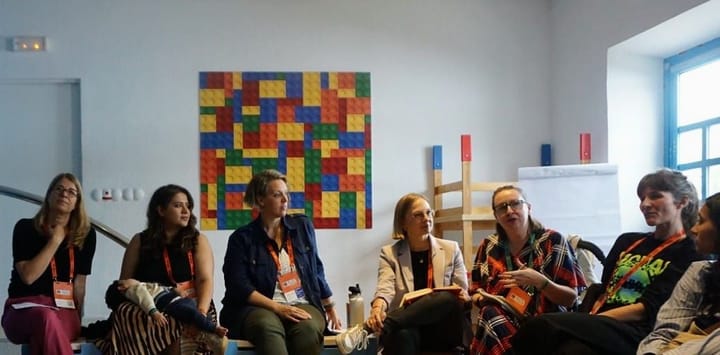What We Learned About Publishing on the Open Social Web
Over two years, we’ve grown alongside the open social web, experimenting with Ghost, ActivityPub, and Bluesky to publish in ways that align with our values.

By Mallory Knodel and Audrey Hingle
Publishing Like It’s 2025
When Mallory started this newsletter in 2023, she knew she wanted it to avoid the pitfalls of billionaire controlled social media. Her background in internet governance and open protocols made it the obvious place to build a publication that aligns with the values of a decentralized web. Over the past two years, the open social web—which includes the ActivityPub-powered Fediverse and emerging networks like Bluesky—has grown from a niche experiment into a meaningful part of the social media landscape, and this newsletter has grown alongside it.
Today, we publish Internet Exchange every week through Ghost, which automatically pushes our content to the Fediverse (Mastodon, Threads, PeerTube, and others) and then bridges to Bluesky via BridgyFed. This means you can follow us from any ActivityPub-enabled account at @ix@internet.exchangepoint.tech and from Bluesky at index.internet.exchangepoint.tech.ap.brid.gy.
Like the Internet Exchange, BridgyFed, FreeOurFeeds and Social Web Foundation are all projects of Exchange Point, the non-profit founded by Mallory that supports initiatives dedicated to transformative technology and social justice, with a focus on advancing public interest technology and open ecosystems.
This year Audrey joined as editor-in-chief, overseeing editorial strategy, shaping voice and tone, and leading audience growth. She has also focused on improving how our publishing workflow connects Ghost with federated platforms. Together, we’ve been figuring out how to make this setup work—not just technically, but editorially and culturally. What follows is what we’ve learned along the way.
Why Ghost and ActivityPub Made Sense
Ghost is an independent publishing platform for people who care about owning their work and their relationship with readers. Founder John O’Nolan describes Ghost as “open source, non-profit, and built to give creators complete ownership of their content and their audience.” Ghost also supports open protocols, which matters for distribution that is resilient and fair.
The big challenge for independent publishers hasn’t changed in two decades: discovery. As O’Nolan puts it, “You can own your platform and serve your audience beautifully, but if people can’t find you, none of it matters.”
While email remains a reliable way to reach readers, it’s still dependent on delivery systems and inbox placement. Algorithms on mainstream social platforms actively suppress links, making it harder to reach new audiences. The integration between Ghost and ActivityPub has the potential to create a more open, free-flowing distribution layer that sidesteps these limits. That potential hasn’t been fully realized yet, but it points toward a model where content circulates across networks without relying on a single company to deliver it.
Setup: Mostly Smooth, a Few Rough Edges
Right now, our setup is optimised for broadcast. We publish in Ghost and the content flows automatically to the open social web, but the engagement layer remains fragmented. There’s no straightforward way to reply to people or interact directly from within Ghost, so any engagement happens natively on each platform and isn’t integrated back into our publishing workflow. Our bridge to Bluesky presents yet another layer of abstraction from our readers there.
Long-form publishing is also still maturing across the Fediverse. On Mastodon or PeerTube or Threads, readers see a title and excerpt with a link to the full article, which works well as a fallback. The ideal is native, full-article reading across apps, but that requires coordination between platforms. It’s a broader ecosystem issue, not just a Ghost limitation, and it’s one Ghost is aware of. The Social Web Foundation and ActivityPub implementers worked in the better part of 2025 to address long-form text.
We also ran into some predictable quirks. Handles generated from domains are long. Mentions don’t always convert cleanly. Logging in to reply on Bluesky through a bridge isn’t even possible (yet?). None of these are dealbreakers, but they are the kinds of issues that come with working with tech that’s still evolving. Our goal is to push the boundaries of the tech so that we can help it expand.
Reflections: Participating in an Evolving Ecosystem
The strongest reason to publish in the open social web is discovery that aligns with our values. ActivityPub provides a way out of the link suppression and opaque algorithms of main-stream social networks. Email lists and ActivityPub both run on open rails, which means no single company can throttle your reach or cut you off from your audience. That’s good for publishers and good for the public.
Publishing long-form content in the Fediverse today is still mostly one-way, but the foundations are solid. ActivityPub is a two-way protocol, and the network becomes healthier when publishers also read and engage. Ghost’s decision to build a reading experience is a step toward making that cultural shift easier.
We started this newsletter with the open social web at the center. Audrey joined to strengthen the workflow, and together we’ve seen how far the tools have come, and how much promise remains. The integration already expands our reach beyond traditional channels, and the engagement model is steadily improving. Still, there’s plenty of room to grow. We want engagement to aggregate back to a single view so small teams (like ours) can keep up. We want native long-form reading across major apps. We want simpler ways to reply to readers where they are.
Our plan is simple: keep publishing, test new features as they roll out, and share what we learn along the way. The goal of IX is to further the field of public interest technology, and we see publishing on the open social web as a central part of that mission. We’re doing this as active participants in the ecosystem: contributing to its growth, learning from others, and sharing what works—and we’re proud to be funding this work through Exchange Point!
Last Chance to Claim Your Internet Exchange Sticker
You might have noticed the new Internet Exchange logo. We’re celebrating the redesign by sending out exclusive stickers to our paid subscribers. If you’ve been thinking about upgrading your subscription, now’s the perfect time — this is your last chance to get one.
I’ll be packing and mailing the stickers this time next week, so make sure you’re a paid subscriber before then to claim yours. Once you upgrade, just revisit this post on the site and the "get a sticker" button will appear automatically.
It’s a small way to say thank you for supporting feminist perspectives on internet governance, privacy, security, and the technologies shaping our future.
Support the Internet Exchange
If you find our emails useful, consider becoming a paid subscriber! You'll get access to our members-only Signal community where we share ideas, discuss upcoming topics, and exchange links. Paid subscribers can also leave comments on posts and enjoy a warm, fuzzy feeling.
Not ready for a long-term commitment? You can always leave us a tip.
This Week's Links
Internet Governance
- Russia’s promotion of the new “Hanoi Convention” on cybercrime is less about tackling cybercrime and more about advancing its long-standing agenda of state-controlled information spaces and cyber sovereignty through the UN. https://www.justsecurity.org/122000/russian-motivations-hanoi-convention-cybercrime
- Google’s new developer registration decree threatens to upend F-Droid and other open app stores, centralising control of Android distribution under the guise of security. https://f-droid.org/en/2025/09/29/google-developer-registration-decree.html
- The IETF has launched a new non-working group mailing list, dns-at-ietf, to coordinate discussions on DNS-related work across multiple IETF areas and working groups. https://mailarchive.ietf.org/arch/msg/ietf-announce/Kx4tcq5jS1P7J9oN505-UU6BYm8
- A coalition of major tech industry groups has urged the US Department of Justice to push back against the UK secret encryption-bypassing orders, warning they endanger global cybersecurity and US tech competitiveness. https://www.reformgovernmentsurveillance.com/post/rgs-led-letter-urges-doj-to-act-against-u-k-orders-threatening-encryption
- The 2025 Summer School on Internet Governance and International Law in Łódź explored the legal, political, and technological dimensions of satellite internet and culminated in the launch of the open-access book Global Governance of Low Earth Orbit Satellites, which features Mallory’s chapter, “Insights from the Internet – How to Govern Outer Space.” https://www.linkedin.com/posts/lodz-cyber-hub_ssigil-ssigil2025-leo-ugcPost-7381627133342760960-aNmI
Digital Rights
- Apple quietly used its anti-hate-speech policies, originally designed to protect marginalized group, to shield ICE agents, blocking an app that documented immigration enforcement. https://migrantinsider.com/p/scoop-apple-quietly-made-ice-agents
Technology for Society
- An Internet Research Task Force report outlines opportunities and research challenges for making networking technologies more sustainable by reducing their environmental impact and greenhouse gas emissions. https://www.rfc-editor.org/info/rfc9845
- Zara Rahman warns of a “crisis of imagination” in the digital rights community, urging activists to move beyond harm mitigation and boldly envision the futures they want to create. https://superrr.net/en/blog/what-are-we-fighting-for
- Nvidia’s dominance in China is under serious threat from geopolitics and Huawei’s ambitions. While it still leads in software and global sales, China’s rapid push for chip self-reliance and ecosystem development could challenge Nvidia’s global position within a few years. https://www.ft.com/content/c24a9b6c-1664-4e46-affb-0c0dc16e3c4a
- Governments and corporations are driving a new “tech arms race,” blurring the line between civilian and military systems and reshaping our towns, politics, and future in the process. https://www.privacyinternational.org/campaigns/militarisation-of-tech
Privacy and Security
- Hackers targeted a third-party firm handling Discord’s age verification, potentially exposing ID photos and personal data from around 70,000 users. https://www.bbc.co.uk/news/articles/c8jmzd972leo
- Peters’ Report finds that DOGE continues to operate unchecked, likely violating federal privacy and security laws, and putting the safety of Americans’ personal information in danger. https://www.hsgac.senate.gov/media/dems/peters-report-finds-that-doge-continues-to-operate-unchecked-likely-violating-federal-privacy-and-security-laws-and-putting-the-safety-of-americans-personal-information-in-danger
- With a growing roster of partners, Amazon has been peddling AI drone surveillance, gun detection and real-time crime center tech to law enforcement agencies, public records reveal. https://www.forbes.com/sites/thomasbrewster/2025/10/01/inside-amazons-aggressive-push-to-get-cops-using-ai-surveillance
- Anthropic’s newly-released Claude Sonnet 4.5 is, by many metrics, its “most aligned” model yet. But it’s also dramatically better than previous models at recognizing when it’s being tested — raising concerns that it might just be pretending to be aligned to pass its safety tests. https://www.transformernews.ai/p/claude-sonnet-4-5-evaluation-situational-awareness
Upcoming Events
- SplinterCon Paris will bring together technologists, researchers, and policymakers to consider what resilient, interconnected digital societies require today and in the future. December 8–10. Paris, France. https://splintercon.net/paris
Careers and Funding Opportunities
United States & Canada
- AI Futures Project: Policy Researcher. Berkeley, CA or Washington, DC. https://docs.google.com/document/u/0/d/1r5YKOUi6gMUZoZvAEh0tHbbHM9RKYk6ONEkw_Tpizb0/mobilebasic
- The World Economic Forum: Specialist, AI Technology and Innovation – AI Governance Alliance. San Francisco, CA. https://weforum.wd3.myworkdayjobs.com/Forum_Careers/job/San-Francisco/Specialist--AI-Technology-and-Innovation—AI-Governance-Alliance_R3332
- The Alaka`ina Foundation Family of Companies (FOCs): AI Ethics Policy Analyst. Washington, D.C. https://phg.tbe.taleo.net/phg04/ats/careers/v2/viewRequisition?org=AKIMEKATECH&cws=43&rid=13259
- Rand: Research Lead - AI Security Policy. Washington, DC. https://rand.wd5.myworkdayjobs.com/External_Career_Site/job/Washington-DC-DC-Metro-Area/Research-Lead—AI-Security-Policy_R3121
- Rand: Research Lead - AI Cyber Testing & Evaluation. Washington, DC. https://rand.wd5.myworkdayjobs.com/External_Career_Site/job/Washington-DC-DC-Metro-Area/Research-Lead----AI-Cyber-Testing---Evaluation_R3122
- AP Policy Institute: Director of Policy. Washington, DC. https://www.linkedin.com/jobs/view/4273048466
- Future of Privacy Forum: Vice President of US Policy. Washington, DC. https://fpf.org/vice-president-of-u-s-policy
- Foundation for American Innovation (FAI): New Program Manager - Governance. Washington, DC. https://airtable.com/appJbp3WUg4zsv7ec/pagTJkHnpvK1ghJe6/form
- ElevenLabs: Public Policy Lead. Remote US. https://jobs.ashbyhq.com/elevenlabs/c26f3fa3-aefb-406d-82d0-854f4664ae4d
- Center for Violence Prevention Research: Data Analyst. Remote US. https://static1.squarespace.com/static/61812e898cd8e779321e61bb/t/68cd773877ae52287f0c1e57/1758295864783/Data+analyst.pdf
- Media Democracy Fund: Executive Director. Remote US. https://www.npag.com/mdf-ed
- Digital Promise: Director of Emerging Technology. Remote US. https://ats.rippling.com/en-GB/digital-promise/jobs/d0d4605a-dadc-49fb-9cae-718ff750aec5
- 1Password: Lead, Responsible AI. Remote US & Canada. https://jobs.ashbyhq.com/1password/441bc5ff-9bac-4d8d-8580-122f1cced83a?departmentId=96a94955-dadd-4290-94ad-1ab70ecccace
Global
- Scyne Advisory: Cyber Advisory (Data & AI Governance) - Senior Manager. Sydney, Australia. https://jobs.smartrecruiters.com/ScyneAdvisory/6000000000484581-cyber-advisory-data-ai-governance-senior-manager?trid=2d92f286-613b-4daf-9dfa-6340ffbecf73
- Discord: Threat Operations Specialist, Child Safety. Remote, Australia. https://discord.com/jobs/8060760002
- EY: Manager / Senior Manager Responsible AI. Paris, France. https://careers.ey.com/ey/job/Paris-La-D%C3%A9fense-Manager-Senior-Manager-%C2%AB-Responsible-AI-%C2%BB-FH-%2528Paris%2529-92037/1220005801/?feedId=337401
- Ezra: Data Protection Officer. Remote, Ghana. https://ezra.world/company/careers/?gh_jid=7234021003&gh_src=7d96b2cc3us
- Ministry of Digital Development and Information Singapore: Deputy Director (Data Governance Transformation), Government Data Division, SNDG. Singapore. https://www.careers.hrp.gov.sg/sap/bc/ui5_ui5/sap/ZGERCFA004/index.html?source=LinkedIn#/JobDescription/16150801/356dfa88-287a-1fd0-9dcc-61d87be173c6
- Singapore Public Service: Assistant Director, Tech Policy. Singapore. https://sggovterp.wd102.myworkdayjobs.com/en-US/PublicServiceCareers/job/Singapore/Assistant-Director--Tech-Policy_JR-10000032497
- Singapore Public Service: Senior Manager / Manager, Product Policy. Singapore. https://sggovterp.wd102.myworkdayjobs.com/en-US/PublicServiceCareers/job/Singapore/Senior-Manager—Manager--Product-Policy--Strategic-Planning-and-Transformation-_JR-10000041207
- Center for Intimacy Justice: Executive Director of CIJ’s Digital Suppression Program. Remote US, EU or UK. https://www.intimacyjustice.org/careers
Opportunities to Get Involved
- Open Call for candidates to serve on the United Nations Independent International Scientific Panel on Artificial Intelligence. Apply by October 31. https://www.un.org/independent-international-scientific-panel-ai/en/open-call
- The Bias Bounty Challenge Set 4 invites participants to uncover and address accessibility and bias issues in virtual meeting platforms like Zoom, with a particular focus on neurodivergent users and the impact of emotion AI detection on their experiences. Prizes range from $500 to $1500. October 6 - November 7. https://humane-intelligence.org/programs-services/bias-bounty/accessibility-challenge-set-4
What did we miss? Please send us a reply or write to editor@exchangepoint.tech.




Comments ()